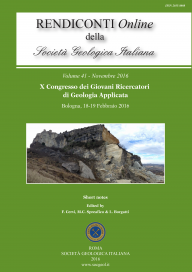
Long-term deformation of slow moving landslides in the Northern Apennines of Italy imaged by SAR interferometry
Filippo Villi (a), Benedikt Bayer (a), Alessandro Simoni (a) & David A. Schmidt (b)
(a) Department of Geological, Biological and Environmental sciences, University of Bologna, Italy. E-mail: benedikt.bayer@studio.unibo.it
(b) Department of Earth and Space Sciences, University of Washington, Seattle, USA
Volume: 41/2016
Pages: 263-266
Abstract
Slow moving earth-flows are a common geomorphological feature in the Northern Apennines and one of the main landscape forming agents. Often houses and small villages were built on these phenomena which are as consequence affected by damages that are caused by small displacements. In this short note, we present the InSAR results obtained from the Stanford Method of Persistent Scatterers (StaMPS) for Cosmo SkyMed and Envisat imagery together with a geological-geomorphological survey. We focus on the village of Gaggio Montano located in the Apennines south of Bologna. Here the tectonically sheared Flysch of the Monghidoro Formation structurally overlies the mélange of the Palombini shales and different complex landslides were mapped on the slope. We show that several landslide bodies are moving with steady deformation rates at least since 2003 and that the results obtained from Envisat and Cosmo SkyMed compare well to each other. Moreover the displacements measured by InSAR are in the same order of magnitude as displacements that have been measured in the past with inclinometers. Because the higher deformation rates are closely related to young houses and industrial complexes, it is possible that anthropogenic factors, like leakage from the water supply/discharge system, influence the displacements. A steady infiltration of water from the Flysch slabs into the clay shales might however represent a possible explanation
Keywords
Get Full Text